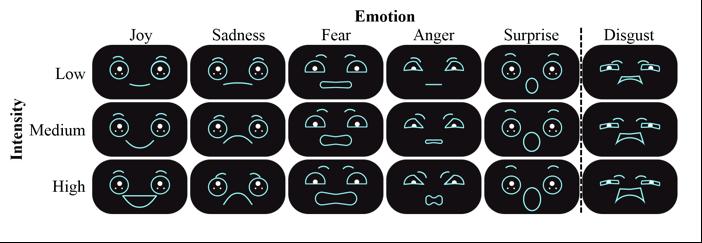BEER-SHEVA, Israel…June 2, 2021 – As drones become more ubiquitous in public spaces, researchers at Ben-Gurion University of the Negev (BGU) have conducted the first studies examining how people respond to various emotional facial expressions depicted on a drone, with the goal of fostering greater social acceptance of these flying robots.
The research, which was presented recently at the virtual ACM Conference on Human Factors in Computing Systems, reveals how people react to common facial expressions superimposed on drones.
BGU researchers conducted two studies using a set of rendered robotic facial expressions on drones that convey basic emotions. The faces use four core facial features: eyes, eyebrows, pupils, and mouth. The results showed that five different emotions (joy, sadness, fear, anger, surprise) can be recognized with high accuracy in static stimuli, and four emotions (joy, surprise, sadness, anger) in dynamic videos. Disgust was the only emotion that was poorly recognized. Click here to watch the “Drone in Love” video.
“Participants were further affected by the drone and presented different responses, including empathy, depending on the drone’s emotion,” Prof. Cauchard says. “Surprisingly, participants created narratives around the drone’s emotional states and included themselves in these scenarios.”
BGU researchers propose a number of recommendations that will enhance the acceptability of drones for use in emotional support and other social situations. These include adding anthropomorphic features, using the five basic emotions, and using empathetic responses to drive compliance in health and behavior change applications.
“BGU is spearheading some of the most remarkable robotic research in the world,” says Doug Seserman, chief executive officer, Americans for Ben-Gurion University. “We foresee continued innovation leveraging human-drone interaction technologies, leading to greater adoption and more beneficial applications.”
###
Andrea Hildebrandt, Carl von Ossietzky Universität Oldenburg and Anastasia Kuzminykh of the University of Toronto also contributed to this study.
About Americans for Ben-Gurion University
Americans for Ben-Gurion University plays a vital role in maintaining David Ben-Gurion’s vision of an “Oxford in the Negev.” By supporting a world-class academic institution that not only nurtures the Negev, but also shares its expertise locally and globally, Americans for Ben-Gurion University engages a community of Americans who are committed to improving the world. The Americans for Ben-Gurion University movement supports a 21st century unifying vision for Israel by rallying around BGU’s remarkable work and role as an apolitical beacon of light in the Negev desert.
For more information visit http://www.
Media Contact
Andrew Lavin
[email protected]
Related Journal Article
http://dx.





